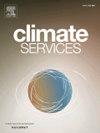Spatio-temporal dynamics of urban heat island using Google Earth Engine: Assessment and prediction—A case study of Kathmandu Valley, Nepal
IF 4
3区 环境科学与生态学
Q2 ENVIRONMENTAL SCIENCES
引用次数: 0
Abstract
This study examines UHI dynamics and impacts in the rapidly urbanizing Kathmandu Valley, Nepal, using remote sensing and predictive modeling. The primary goals are to evaluate UHI trends and explore how urbanization influences temperature and climate change. To achieve these objectives, the research investigates the relationship between spectral characteristics, Land Use Land Cover (LULC), and UHI, utilizing high-resolution data from MODIS and Landsat satellites to analyze land surface temperature (LST) and land use changes over recent decades. The study employs Cellular Automata-Markov (CA-Markov) modeling to predict future UHI dynamics, taking into account climatic variability, land use changes, and population growth. Findings reveal significant increases in LST and UHI intensity due to the expansion of impermeable surfaces and loss of vegetative cover. Predictions for 2030 indicate higher LSTs, with winter temperatures ranging from 9.34 °C to 30.12 °C and summer temperatures from 19.74 °C to 42.32 °C, showing an increase compared to 2020. Additionally, the UHI effect is predicted to intensify due to expanding built-up areas, with greater seasonal variation observed in summer. The results suggest that without effective mitigation, UHI will continue to worsen, exacerbating climate-related issues. Insights into the relationship between spectral parameters, LULC, and UHI can guide strategies to mitigate UHI effects, promote sustainable urban growth, and improve urban resilience. Integrating remote sensing technologies with predictive modeling is crucial for addressing urbanization and climate change challenges.
基于谷歌地球引擎的城市热岛时空动态评价与预测——以尼泊尔加德满都谷地为例
本研究利用遥感和预测模型研究了快速城市化的尼泊尔加德满都谷地的热岛动态及其影响。主要目标是评估城市热岛的趋势,并探索城市化如何影响温度和气候变化。为了实现这些目标,本研究利用MODIS和Landsat卫星的高分辨率数据分析近几十年来地表温度(LST)和土地利用变化,研究了光谱特征、土地利用、土地覆盖(LULC)和城市热岛指数之间的关系。该研究采用元胞自动机-马尔可夫(CA-Markov)模型来预测未来的热岛热岛动态,同时考虑到气候变化、土地利用变化和人口增长。研究结果表明,由于不透水表面的扩大和植被覆盖的丧失,地表温度和热岛热强度显著增加。对2030年的预测表明地表温度更高,冬季气温在9.34°C至30.12°C之间,夏季气温在19.74°C至42.32°C之间,与2020年相比有所增加。此外,由于建成区的扩大,预计热岛效应将加剧,夏季观测到的季节变化更大。结果表明,如果没有有效的缓解措施,热岛问题将继续恶化,从而加剧与气候有关的问题。深入了解光谱参数、土地利用成本和城市热岛指数之间的关系,可以指导缓解城市热岛指数影响、促进城市可持续增长和提高城市韧性的策略。将遥感技术与预测建模相结合对于应对城市化和气候变化挑战至关重要。
本文章由计算机程序翻译,如有差异,请以英文原文为准。
求助全文
约1分钟内获得全文
求助全文
来源期刊

Climate Services
Multiple-
CiteScore
5.30
自引率
15.60%
发文量
62
期刊介绍:
The journal Climate Services publishes research with a focus on science-based and user-specific climate information underpinning climate services, ultimately to assist society to adapt to climate change. Climate Services brings science and practice closer together. The journal addresses both researchers in the field of climate service research, and stakeholders and practitioners interested in or already applying climate services. It serves as a means of communication, dialogue and exchange between researchers and stakeholders. Climate services pioneers novel research areas that directly refer to how climate information can be applied in methodologies and tools for adaptation to climate change. It publishes best practice examples, case studies as well as theories, methods and data analysis with a clear connection to climate services. The focus of the published work is often multi-disciplinary, case-specific, tailored to specific sectors and strongly application-oriented. To offer a suitable outlet for such studies, Climate Services journal introduced a new section in the research article type. The research article contains a classical scientific part as well as a section with easily understandable practical implications for policy makers and practitioners. The journal''s focus is on the use and usability of climate information for adaptation purposes underpinning climate services.
 求助内容:
求助内容: 应助结果提醒方式:
应助结果提醒方式:


